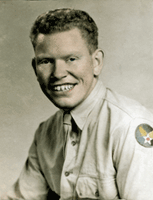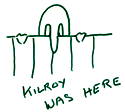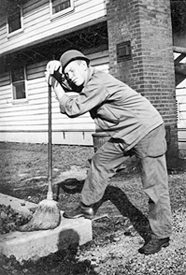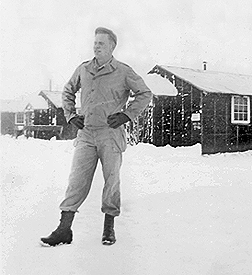The Stamford Historical Society Presents
Pride and Patriotism: Stamford’s Role in World War II
Online Edition
The Interviews
Julian Reitman
Julian Reitman was drafted and ended up in the Army Air Corps where he worked as a radio mechanic. He worked with the British designed radio set designed to communicate with planes. He had begun training with radar when the war ended.
 WWII I was in the Air Corps…you have to recognize what was the Army Air Corps…we belonged to the Army...the problem Air Corps had was that airplanes needed to communicate…they needed radios…radios were not reliable…they had vacuum tubes, they failed, they were unreliable. As result Signal Corps had lots of radios working on the ground but not on planes...there was a need for radio mechanics.
WWII I was in the Air Corps…you have to recognize what was the Army Air Corps…we belonged to the Army...the problem Air Corps had was that airplanes needed to communicate…they needed radios…radios were not reliable…they had vacuum tubes, they failed, they were unreliable. As result Signal Corps had lots of radios working on the ground but not on planes...there was a need for radio mechanics.
During the Battle of Britain, the critical thing was radio direction – how tell the pilot where to go and how to get home...they need reliable radios…it was a huge problem. The Air Corps couldn’t get around it… I was involved with the SCR 522 VHF command set…it was a line of sight communication so a fighter pilot could be zeroed back to home base hopefully…the nature of high frequency communication was at 106-155 megacycles, it was unreliable and many pilots got vectored to the wrong place.
I turned 18, got drafted, ended up in an Army reception center at Camp Upton Long Island…they called men out for flight training… you should not volunteer for anything…the choice didn’t sound great, you had to take test to qualify or go on KP,...so I took the test, then I went off to basic training at Greeensboro North Carolina. The Air Corps needed guys…gunners, pilots, etc,. there were supposedly lot of 17 year old aviation cadets… they gave serious tests in North Carolina and 98% flunked out…really had a bunch of guys under false pretense… I ended up passing the test for pilot or navigator, but not for bombardier, because I was left handed….
I expected to go into the program, actually they shipped us out on a train then took us back to Greeensboro, North Carolina. The Air Corps counted up the people in training programs and ended up with 75,000 more than needed. A couple of weeks later someone came round asking about gunners… I had flunked the code test, I was not great on Morse code so I went to train as mechanic gunner… then I was off on troop train to Scott Field, Illinois. I went to radio school in Belleville, Illinois and trained to be a radio operator. The test was accurate. I could copy code five character blocks, 8, 12, 15 words a minute error rate the same…with that error rate they didn’t want you on an airplane…they decided to flunk me out and I got sent to radio mechanics’ school Madison, Wisconsin… into tarpaper one-storey barracks for a Wisconsin winter. We had a pot belly stove with soft coal to keep warm…when we went to sleep, the stove wouldn’t stay warm…so you have someone get up in middle of night, but usually no one did so it was cold.
I had one year of college…at the end of my training course they asked, “Do you want to be an instructor?” “Why not?” I said. I had graduated at the top of the class. My one year at CCNY meant there would be interrogations. The FBI was looking for Reds in the Air Corps… I knew the basketball coach at CCNY, no problem.
SCR 522 was a British Command set, designed in England. Everyone copied it. I was to work on it. It was not a reliable radio…it was a first attempt, but still no good. The mechanical tuning was the problem. With altitude, the change in temperature would loosen the mechanical structure. There were four channels, if fourth one goes off, no way to get home.
It was a complicated transmitter/receiver at high frequency. It was not clear that the Germans had equivalent radios, standardized on tubes that were less effective.
Then they decided to send me to radar school, to Chanute Field, Illinois, then on to Boca Raton. The war was over, the Japs surrendered. They wanted me to go to Japan, but then realized the point system would allow me to return. I was made an aviation cadet and discharged. I got out with two years of service instead of three. I went back to CCNY.
I learned the future of electronics at Scott field. One could use vacuum tubes for control. I learned what was crucial to my future interests, focused on designing systems…
I had been studying electric engineering at CCNY before I was drafted in 1943. If I had not ended up in Air Corps I would have ended up in the Battle of the Bulge.
I was not part of a unit…just whatever group I was working with at that period, so there was no time to really make deep friendships…etc. I did keep in touch with some people, but I was constantly moving from one part of training command to another and guys were moving in and out of barracks every week, age bracket 18-26.
Classes were round the clock. 4 to 11, 12 to7, 8 to 3…all day. There were different people in each one of these shifts… at 11 you had breakfast… line up, march back to barracks… I also had PT.
We would sometimes fall out for mess call 1AM...2AM at mess hall, ate your breakfast ready to serve at 3AM…supposed to get off by 3PM, sometimes not till 5PM(KP Duty at Scott Field).
Guard Duty: four hours on, four hours off…Chanute Field guard duty in hangars…
Vacuum tubes didn’t like flying, landing etc. …lots of failures, unreliable equipment…fix things, but pulling out vacuum tubes, test them and replace them…when you take them out, then replace them, you can also damage them….not reliable. Technology for radars was moving faster than radios...they were just thrown together.
Photos Courtesy Julian Reitman
 Introduction
Introduction
Veterans
Battles
Stamford Service Rolls
Homefront
Exhibit Photos
Opening Day





 Introduction
Introduction WWII I was in the Air Corps…you have to recognize what was the Army Air Corps…we belonged to the Army...the problem Air Corps had was that airplanes needed to communicate…they needed radios…radios were not reliable…they had vacuum tubes, they failed, they were unreliable. As result Signal Corps had lots of radios working on the ground but not on planes...there was a need for radio mechanics.
WWII I was in the Air Corps…you have to recognize what was the Army Air Corps…we belonged to the Army...the problem Air Corps had was that airplanes needed to communicate…they needed radios…radios were not reliable…they had vacuum tubes, they failed, they were unreliable. As result Signal Corps had lots of radios working on the ground but not on planes...there was a need for radio mechanics.